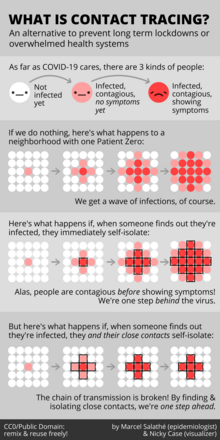
Back متابعة مخالطي المرضى Arabic সংক্রমণ-বাহক অনুসন্ধান Bengali/Bangla Heuliañ an darempredoù (medisinerezh) Breton Rastreig de contactes Catalan Trasování (epidemiologie) Czech Kontaktopsporing Danish Contact tracing DAG Kontaktpersonennachverfolgung German Rastreo de contactos Spanish Aztarnari Basque

In public health, contact tracing is the process of identifying persons who may have been exposed to an infected person ("contacts") and subsequent collection of further data to assess transmission.[1][2] By tracing the contacts of infected individuals, testing them for infection, and isolating or treating the infected, this public health tool aims to reduce infections in the population.[2] In addition to infection control, contact tracing serves as a means to identify high-risk and medically vulnerable populations who might be exposed to infection and facilitate appropriate medical care.[1] In doing so, public health officials utilize contact tracing to conduct disease surveillance and prevent outbreaks.[2] In cases of diseases of uncertain infectious potential, contact tracing is also sometimes performed to learn about disease characteristics, including infectiousness.[1][2] Contact tracing is not always the most efficient method of addressing infectious disease.[2] In areas of high disease prevalence, screening or focused testing may be more cost-effective.[1][2]
The goals of contact tracing include:[3]
- Interrupting ongoing transmission and reduce the spread of an infection
- Alerting contacts to the possibility of infection and offer preventive services or prophylactic care
- Alerting the general public about exposures or outbreaks (IE: COVID-19, Measles, TB, etc)
- Offering diagnosis, counseling and treatment to already infected individuals
- If the infection is treatable, helping prevent reinfection of the originally infected patient
- Learning about the epidemiology of a disease in a particular population
- Being a tool in multifaceted prevention strategy to effectively curb the spread of an infectious disease.

- ^ a b c d "Coronavirus disease (COVID-19): Contact tracing". www.who.int. Retrieved 2022-11-03.
- ^ a b c d e f "The History of Contact Tracing and the Future of Public Health". American Journal of Public Health. 112 (8): 1097–1099. August 2022. doi:10.2105/AJPH.2022.306949. PMC 9342804. PMID 35830671.
{{cite journal}}: Unknown parameter|v authors=ignored (help) - ^ "Health Departments". Centers for Disease Control and Prevention. 2020-02-11. Retrieved 2022-11-03.
© MMXXIII Rich X Search. We shall prevail. All rights reserved. Rich X Search